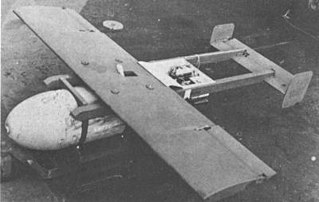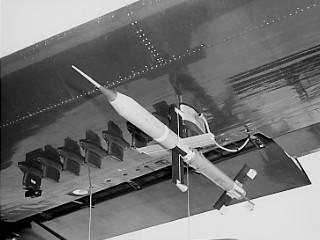
The AUM-N-2 Petrel, also known as Kingfisher C and AUM-2, was an air-to-surface missile produced as part of Project Kingfisher for the United States Navy. Intended for use against enemy surface ships and surfaced submarines, giving aircraft the ability to deliver aerial torpedoes from outside the range of defensive armament, it saw brief operational service in the late 1950s. The project was never considered a high priority by the Navy however, as it was useless against submerged submarines, which were considered the greatest potential threat.

The Gorgon missile family was a series of experimental air-to-air, air-to-surface, and surface-to-surface missiles developed by the United States Navy's Naval Aircraft Modification Unit between 1943 and 1953. The immaturity of the technology involved meant that none of the Gorgon missiles achieved operational service, however they were extensively used in the development of guided missile controls and guidance technologies.

Project Kingfisher was a weapons-development program initiated by the United States Navy during the latter part of World War II. Intended to provide aircraft and surface ships with the ability to deliver torpedoes to targets from outside the range of defensive armament, six different missile concepts were developed; four were selected for full development programs, but only one reached operational service.

The VB-6 Felix was a precision-guided munition developed by the United States during World War II. It used an infrared seeker to attack targets like blast furnaces or the metal roofs of large factories. The war ended before it could be used operationally.

The LBD-1 Gargoyle was an American air-to-surface missile developed during World War II by McDonnell Aircraft for the United States Navy. One of the precursors of modern anti-ship missiles, it was extensively used as a test vehicle during the late 1940s.
The Fletcher FBT-2 was a military trainer aircraft built in the United States in the early 1940s. Although it was never entered production as a trainer, it was ordered in small numbers as a target drone but when that was cancelled played a small part in the development of guided bombs.
The Cornelius XBG-3 was an American "bomb glider", developed by the Cornelius Aircraft Corporation for the United States Army Air Forces. Using an unconventional design that included a forward-swept wing, a single prototype was ordered in 1942; however the contract was cancelled later that year before the aircraft had been constructed.

The Pratt-Read LBE-1 was a prototype glide bomb, or "Glomb", developed for the United States Navy during World War II. Although there were high hopes for the concept, the limitations of the Glomb led to the production contract for the LBE-1 being reduced, then cancelled, and only four examples of the type were ever built.

The Piper LBP was a glide bomb, or "Glomb", developed by Piper Aircraft for the United States Navy during World War II. Developed as one of three "Glomb" aircraft, the inherent limitations of the Glomb and the technology of the time, combined with difficulties encountered in testing of the prototype, led to the production contract for the LBP-1 being reduced, then cancelled, with none of the Glomb aircraft ever seeing operational service.

The Taylorcraft LBT was a glider designed and built by Taylorcraft during World War II, in response to a United States Navy requirement for a glide bomb. One of three prototype "Glomb" models ordered by the Navy, the LBT suffered from technical and performance difficulties, and was cancelled early in production, none of the aircraft seeing operational service.

The JB-4, also known as MX-607, was an early American air-to-surface missile developed by the United States Army Air Forces during World War II. Using television/radio-command guidance, the JB-4 reached the flight-testing stage before being cancelled at the end of the war.

The AAM-N-5 Meteor was an early American air-to-air missile, developed by the Massachusetts Institute of Technology and Bell Aircraft for the United States Navy. Initially, both air-launched and ship-launched versions were considered. Versions designed for launch from carrier-based aircraft proceeded to the flight testing stage before the project was cancelled.

The CTV-N-2 Gorgon IIC – also designated KGN, KUN, and CTV-2 – was an experimental drone, originally intended as a surface-to-surface missile, developed by the United States Navy near the end of World War II. It was used to test control and homing systems for guided missiles, and was also produced in small numbers as a target drone under the designations TD3N and KD2N.

The KA2N Gorgon IIA – also designated KU2N, CTV-4, and CTV-N-4 – was an air-to-air missile developed by the United States Navy near the end of World War II. Proving a failure in its designed role, it was repurposed as an experimental testbed for missile technology.

The Pelican, also known as Bomb Mark 55 and, in one version, SWOD Mark 7, was a guided bomb developed by the United States Navy during World War II. Guided by semi-active radar homing, Pelican was produced in 1,000 lb (450 kg) and 1,500 lb (680 kg) sizes; the program reached the stage of live trials before being cancelled.

The GB-1, also known as the "Grapefruit bomb" and as XM-108, was a glide bomb produced by Aeronca Aircraft for the United States Army Air Forces during World War II. Intended to allow bombers to release bombs from outside the range of enemy defenses, over one thousand GB-1s were used in combat before the end of the war.

The ASM-N-6 Omar was a short-range air-to-surface missile developed for and evaluated by the United States Navy in the early 1950s. Intended to use existing unguided rockets as a basis and using a novel guidance system involving optical beam-riding, the program was unable to resolve difficulties with the guidance system and was cancelled without entering service.

The AUM-N-6 Puffin, also known as Kingfisher F and AUM-6, was an anti-ship and anti-submarine missile developed for use by the United States Navy in the late 1940s. Pulsejet-powered and intended to allow an aircraft to launch a torpedo or bomb from stand-off range, it was flight-tested but failed to enter operational service.

The SUM-N-2 Grebe, also known as Kingfisher E and SUM-2, was a rocket- and pulsejet-powered anti-ship and anti-submarine missile developed by the United States Navy in the late 1940s. Intended to allow a ship to deliver a torpedo at a significant distance from the launch location, it proved impractical in trials, and did not enter operational service.


















